Pimples and Acne
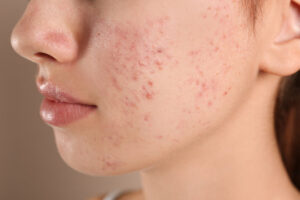
Pimples are a common skin condition caused by clogged or inflamed oil glands or an increased presence of pimple-causing bacteria on your skin. They’re a symptom of acne, and there are many different types, including blackheads, whiteheads, cysts and others. Treatments include home remedies and over-the-counter and prescription pills and gels .
Pimples are small growths on the surface of your skin. They may become inflamed or discolored. Acne typically causes pimples to develop, most commonly on your face, chest, shoulders and upper back.
Pimples affect:-
For many people who have acne, the skin disease affects more than their appearance. Acne can take a toll on one’s emotional health. Researchers have found in study after study that people with acne can also develop:
Depression
Anxiety
Low self-esteem
Poor self-image
Decreased quality of life
A feeling of being all alone
Pimples typically affect teenagers (adolescents) and young adults undergoing hormonal changes. However, they can affect babies, and many adults continue to have pimples into their 20s, 30s and beyond. Some even develop pimples for the first time as adults.
Difference between acne and pimples :-
Acne is a disease. Pimples may be a symptom of acne.
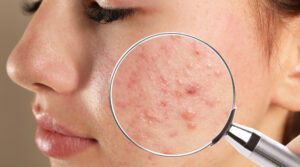
Causes of Acne :-

Doctors and researchers believe that one or more of the following can lead to the development of acne:-
Excess or high production of oil in the pore.
Buildup of dead skin cells in the pore.
Growth of bacteria in the pore.
The following factors may increase your risk for developing acne:-
Hormones. An increase in androgens, which are male sex hormones, may lead to acne. These increase in both boys and girls normally during puberty and cause the sebaceous glands to enlarge and make more sebum. Hormonal changes related to pregnancy can also cause acne.
Family history. Researchers believe that you may be more likely to get acne if your parents had acne.
Medications. Certain medications, such as medications that contain hormones, corticosteroids, and lithium, can cause acne.
Age. People of all ages can get acne, but it is more common in teens.
The following do not cause acne, but may make it worse :-
Diet. Some studies show that eating certain foods may make acne worse. Researchers are continuing to study the role of diet as a cause of acne.
Stress.
Pressure from sports helmets, tight clothes, or backpacks.
Environmental irritants, such as pollution and high humidity.
Squeezing or picking at blemishes.
Scrubbing your skin too hard.
Symptoms of Pimples:-
There are many types of pimples, and the symptoms depend on which kind you have. These include:
Papules:
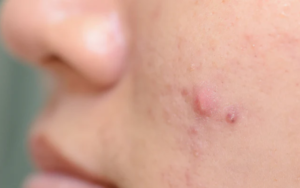
A papule is a raised area of skin tissue that’s less than 1 centimeter around. A papule can have distinct or indistinct borders. It can appear in a variety of shapes, colors, and sizes. It’s not a diagnosis or disease.
Papules are often called skin lesions, which are essentially changes in your skin’s color or texture. Sometimes, papules cluster together to form a rash.
In most cases, papules are not serious. Depending on the cause of the papule, such as a wart, it can be relieved with home treatments.
However, if the papules appear soon after you start a new medication, consult your doctor immediately.
Blackheads:
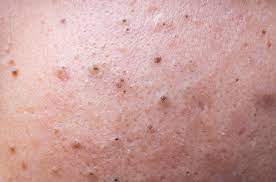
Blackheads are small, dark lesions that appear on the skin, often on the face and neck. They are a feature of mild acne, but they can appear without other signs of acne being present.
These are open pores on your skin that contain excess oil and dead skin. It looks like there’s a speck of dirt or a dark spot in the bump. But irregular light reflection off the clogged follicle causes the dark spots.
Whiteheads:
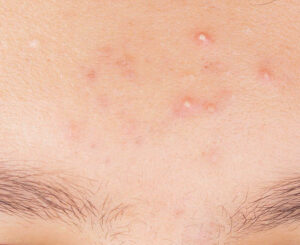
Whiteheads are a mild and routine type of acne commonly called pimples. They develop when sebum plugs the opening of hair follicles, clogging pores. They appear as flesh-colored pimples and usually clear without the need for prescription medications.
These are bumps that remain closed by oil and dead skin. They’re white or yellowish in appearance.
Nodules:
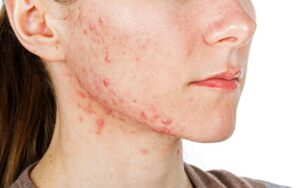
These are rounded or unusually shaped masses. They may be deep in your skin, and they’re often painful.
Pustules:
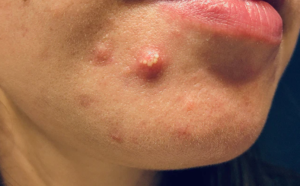
These are pus-filled pimples that look like whiteheads surrounded by discolored rings. Picking or scratching your pustules can cause scarring.
Cysts:
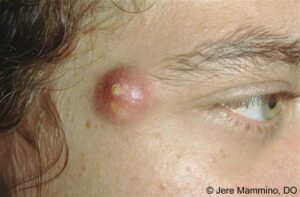
These are pimples filled with a thick, yellow or white fluid composed of dead white blood cells, small pieces of tissue and bacteria (pus). Cysts can cause scars.
How common are pimples :-
Pimples are very common. Some researchers suggest that pimples affect nearly everyone at some time during their lives. They’re most common during adolescence, but adults may have them, too.
Pimples affects on body :-
Your face (especially your nose, chin and forehead, and sometimes your cheeks or around your lips), neck, back, chest and upper arms are most likely to develop pimples. However, oil glands are all over your body. They release an oily lubricant called sebum that helps keep your skin and hair hydrated and shiny. As a result, though it isn’t common, pimples sometimes appear on your eyelids (styes), butt, ears, scalp, armpits (axilla) and external genitals (penis or labia).
Pimples don’t seriously affect your physical health, but they can affect you psychosocially (how society and social groups affect your mind) and psychologically (your self-perception and behavior). They’re sometimes associated with anxiety, depression, mood disorders and suicidal thoughts.
Pimple formation :-

Pimples are hard and inflamed spots on the skin. They originate in the follicles when dead skin cells mix with excess oil, causing bacteria to grow and clog the pores. Pimples typically form on your face, neck, back, chest, or shoulders and can appear at any age. Although pimples are common, the effects go beyond the skin’s surface.
Sometimes, skin gets irritated by things it comes in contact with and pimples develop. Most people think of acne when they think of pimples. Oil glands (sebaceous glands) are located all over your body. Clogs or inflammation in your sebaceous glands cause pimples to form. Clogs and inflammation can occur as a result of:
Increased sebum (oily material produced by the sebaceous gland) production.
Abnormal formation of keratin (the protein that helps make your hair, skin and nails).
Increased presence of bacteria on your skin that causes pimples.
Are pimples contagious?
Pimples aren’t contagious. You can’t spread them to another person through skin-to-skin contact.
Diagnosis :-
Pimples are easy to recognize, so you don’t necessarily need a healthcare professional to diagnose them. But your healthcare provider can diagnose pimples during a skin exam.
They may ask if you’re undergoing significant stress or if you have a family history of pimples, which are risk factors. If you menstruate, your healthcare provider may ask about your menstrual cycles, as pimple breakouts are sometimes related. Sudden, severe pimple outbreaks in people 50 years of age or older can sometimes signal another underlying disease that requires medical attention.
If you have severe pimples (cystic acne), see a dermatologist for treatment. Dermatologists are doctors who specialize in conditions that affect your skin, hair and nails.
Many people can diagnose acne on their own, particularly in mild cases; most people recognize the symptoms of this very common skin condition. But while you may be familiar with what an occasional zit looks like, there is actually a wide range of severity. Seeing a dermatologist to formally diagnose acne can be very helpful, as different grades of acne usually require different types of treatments. There are also several other skin conditions that mimic acne, which may need a different approach entirely.
Management and Treatment :-
Nonprescription medications can get rid of milder cases of pimples. Some medications include:
Azelaic acid: This is a natural acid found in various grains such as barley, wheat and rye. It kills microorganisms on your skin and reduces swelling.
Benzoyl peroxide: This is available as an over-the-counter product (such as Clearasil®, Stridex® and PanOxyl®). Lower concentrations and wash formulations are less irritating to your skin. Irritation (dryness) is a common side effect.
Retinoids (vitamin A derivatives): Retinoids, such as Retin-A®, Tazorac® and Differin® help prevent clogged pores. You may notice a change in skin color or peeling. Using retinoids every other day or using them at the same time as a moisturizer can reduce these side effects.
Salicylic acid: This is available over-the-counter for pimples as a cleanser or lotion. It helps dissolve dead skin cells to prevent your hair follicles from clogging.
If your pimples don’t go away with nonprescription medications, your healthcare provider may recommend prescription medications, including antibiotics and oral hormone replacement.
Other therapies may include:-
Chemical peels: Chemical peels use a mild chemical solution to remove layers of skin and reduce pimples.
Laser skin resurfacing:
Laser skin resurfacing directs short, concentrated pulsating beams of light at your pimples. The light beams reduce the amount of oil that your sebaceous glands produce.
Microdermabrasion:
A dermatologist or plastic surgeon uses a specialized instrument to “sand” your skin. Removing the top layers of your skin frees the clogs that cause pimples.
Talk to your Doctor healthcare provider before trying these — they may be irritating and make acne worse.
Home remedies for pimples :-
While home remedies are safe for most people, it’s a good idea to check with your Doctor healthcare provider before trying some of the following options. You may be at risk of developing an allergic reaction.
Some home remedies include:-
Tea tree oil: Tea tree oil can prevent or stop the growth of bacteria. Apply a small amount of tea tree oil to a cotton applicator and rub it on your pimples.
Sugar or salt scrubs: Sugar and salt scrubs scratch away (exfoliate) dead cells on the surface of your skin. Wet your face, apply a salt or sugar scrub to your pimples and massage your skin in small, circular motions for up to 30 seconds. Rinse your face with water when you’re finished.
Green tea: Wet green tea leaves can help reduce oil production in your skin. Green tea is also an antioxidant. Mix dry green tea leaves with water and massage the wet leaves into your skin in small, circular motions for up to 30 seconds. Rinse your face with water when you’re finished.
Warm compress: A warm compress increases blood blow to your pimples, which causes them to heal faster. Soak a clean washcloth or small towel in very warm water — around 95 degrees Fahrenheit (35 degrees Celsius) — and apply it to your pimples. Apply the warm compress to your pimples three to four times a day.
Ice: Ice can slow down the amount of blood that flows to your pimples, which will reduce inflammation and pain. Apply an ice cube or ice pack covered in a light towel over your pimples for at least 10 minutes. Apply ice to your pimples two to three times a day.
Squeeze or pop pimples :-
Popping pimples can be very tempting — and satisfying. However, it’s best if you don’t squeeze or pop your pimples. Squeezing pimples can cause several problems, including:-
Introducing bacteria into the pimple opening. Bacteria can cause an infection.
Irritating your skin. Your skin is sensitive, and your nails are much stronger than your skin. When you use your nails to apply a lot of pressure to your skin to pop a pimple, you can cause inflammation. Pimple-popping tools (blemish extractors) can also damage your skin. Only a healthcare provider, medical aesthetician or dermatologist should use these tools.
Scarring your skin. You can draw blood and seriously damage your skin if you apply too much pressure. If pimples are deep in your skin, you may not even extract them.
Duration of pimples :-
Pimples usually last between three and seven days. Most pimples go away on their own, but it may take some time. Deep pimples (pimples under your skin with no head that may feel hard to the touch) may take a few weeks to go away, if not longer.
It’s better to see your healthcare provider at the first sign of pimples and follow their treatment suggestions.
Diet for pimples :-
Healthcare providers and researchers once believed that certain foods might contribute to the development of pimples, especially skim milk, whey protein and diets high in sugar (including chocolate). However, that may not be true. The research between diet and pimples isn’t clear.
But certain vitamins promote healthy skin, which may help prevent pimples. These include:
Vitamin A: Good sources of vitamin A include leafy green vegetables, orange and yellow vegetables, tomatoes, fruits, fish and liver.
Vitamin D: Good sources of vitamin D include fatty fish (mackerel, salmon, trout and tuna) and vitamin-fortified foods, including dairy and nondairy milks, breakfast cereals and orange juice.
Vitamin E: Good sources of vitamin E include nuts, seeds, leafy green vegetables and vegetable oils.
Self Management of pimples :-
If you have pimples, be careful managing them to avoid irritation. You can do this by:
Not touching or picking at your pimples.
Being careful around your pimples while shaving.
Regularly cleaning items that touch your face, including your cell phone, sports helmets, sunglasses, clothing and pillowcases.
You can also use over-the-counter acne medications like benzoyl peroxide or salicylic acid. These come in many forms. A wash is the least irritating.
Prevention :-
Wash your face once or twice daily with warm water and a mild facial cleanser.
You don’t have to stop using makeup, but try using non-comedogenic products and always remove your makeup at the end of each day.
Preventing pimples is difficult, if not impossible, during normal hormonal changes. But the following tips may help:
Routinely wash your hair — be sure to include your hairline along your forehead.
Keep hair gels and other products away from your face.
Try not to touch your skin on your face with your hands.
Routinely use moisturizers made for your face — be sure they have no perfumes and are non-comedogenic (not acne causing).
Approx. time for pimples :-
Pimples often go away in early adulthood, though some people will continue having them throughout their lives. Your healthcare provider can help you manage your pimples.
Consult to Doctor healthcare provider for Pimples :-
If you get a large outbreak of pimples at once or if you have pimples that get large, discolored or painful, you should consult to your Doctor healthcare provider.
Difference between genital herpes and pimples :-
Genital herpes is a common sexually transmitted infection (STI) that causes painful blisters on your genitals. Herpes simplex virus type 2 (HSV-2) causes genital herpes, and the virus is highly contagious. You can spread genital herpes very easily through saliva, semen and vaginal secretions through sexual intercourse and other forms of skin-to-skin contact.
Pimples on your genitals usually aren’t painful. They can appear in areas of your skin that press tightly against your underwear or clothing, which causes dirt, oil and sweat to accumulate and clog your pores. You can’t spread genital pimples through sexual intercourse or other forms of skin-to-skin contact.
Difference between a cold sore and a pimple :-
Cold sores are tiny blisters that appear on your lips and around your mouth. Herpes simplex virus type 1 (HSV-1) causes cold sores, and the virus is highly contagious. You can spread cold sores very easily through saliva or close contact with another person who has a cold sore outbreak — often through kissing or sharing utensils, straws, towels or lip balm.
Pimples don’t form on your lips or inside your mouth. You can’t spread pimples through saliva or close contact with another person who has pimples.
Difference between a boil and a pimple :-
Boils (furuncles) are pus-filled bumps that develop deep in your skin. They usually begin as discolored bumps, which quickly increase in size and fill with pus. The bacteria Staphylococcus aureus causes boils and staph infections.
The following tips can help you tell the difference between a boil and a pimple:
Boils don’t respond to typical pimple treatments.
Boils usually form around cuts or scratches on your skin.
Pimples aren’t usually as painful as boils.
Note
Pimples are a common skin condition that affects most people, especially adolescents. Because it mainly affects teenagers, many people think pimples are part of the transition from childhood to adulthood and don’t see a healthcare provider about them. But despite how common they are, they can severely affect your mental health and cause permanent skin damage. If you notice symptoms of anxiety or depression due to the presence of pimples, talk to your Doctor healthcare provider.